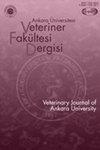Clinical-haemostasis assessment of anaesthesia regimens in dogs with visceral and somatic types of pain response
IF 0.9
4区 农林科学
Q3 VETERINARY SCIENCES
引用次数: 0
Abstract
The article investigates the influence of visceral (surgical treatment of abdominal pathologies) and somatic pain syndrome (osteosynthesis) on dogs’ clinical parameters and haemostasis. It was found, that the best variant for abdominal operations in dogs is acepromazine-ketamine-propofol anaesthesia and for osteosynthesis – acepromazine-butorphanol-ketamine. The use of neuroleptics (acepromazine, xylazine) with general anaesthetics (ketamine, propofol, sodium thiopental) in abdominal operations ensured rapid entry into anaesthesia (< 2 min) and duration 19–23 min. The use of acepromazine-ketamine-propofol provided well-managed anaesthesia during 11.1 ± 0.5 min, rapid recovery (17.3 ± 2.4 min), without significant changes in heart rate (HR), respiratory rate (RR), blood pressure (BP), haemoglobin saturation (SpO2). Unbalanced anaesthesia and insufficient analgesia under xylazine-ketamine caused a sharp decrease in HR, BP, RR with their increase due to visceral pain, led to hypoxia (SpO2 < 92%). During the osteosynthesis, acepromazine-butorphanol-propofol-ketamine anaesthesia provided complete analgesia with twice the rapid recovery of dogs without significant changes in HR, RR, BP, SpO2 during surgery. Acepromazine-ketamine-thiopental anaesthesia accompanied by pronounced analgesia with a decrease in HR and BP. Xylazine-ketamine-thiopental anaesthesia, under apparent analgesia, led to hypotension (decreased HR, BP) and hypoxia (decreased RR, SpO2). The data obtained will optimize the selection of drugs' combinations for dogs' anaesthesia, taking into account the type of pain response.麻醉方案对内脏和躯体类型疼痛反应犬的临床止血评估
本文研究了内脏(腹部疾病的外科治疗)和躯体疼痛综合征(骨合成)对犬临床参数和止血的影响。研究发现,狗腹部手术的最佳变体是乙酰丙嗪-氯胺酮-丙泊酚麻醉,以及用于骨合成的最佳变体——乙酰丙嗪丁啡醇-氯胺酮。腹部手术中使用神经抑制剂(乙酰丙嗪、甲苯噻嗪)和全身麻醉剂(氯胺酮、丙泊酚、硫喷妥钠)可确保快速进入麻醉状态(<2分钟),持续时间为19-23分钟。使用乙酰丙嗪-氯胺酮-丙泊酚可在11.1±0.5分钟内提供良好的麻醉管理,快速恢复(17.3±2.4分钟),心率(HR)无显著变化,呼吸频率(RR)、血压(BP)、血红蛋白饱和度(SpO2)。甲苯噻嗪-氯胺酮麻醉不平衡和镇痛不足导致HR、BP、RR急剧下降,并因内脏疼痛而增加,导致缺氧(SpO2<92%)。在接骨过程中,乙酰丙嗪-布托啡醇-丙泊酚-氯胺酮麻醉提供了完全的镇痛作用,其快速恢复速度是狗的两倍,手术期间HR、RR、BP和SpO2没有显著变化。乙酰丙嗪-氯胺酮硫喷妥钠麻醉伴随显著镇痛,HR和BP降低。二甲苯胺-氯胺酮硫喷妥钠麻醉在明显镇痛下导致低血压(HR、BP降低)和缺氧(RR、SpO2降低)。所获得的数据将优化狗麻醉药物组合的选择,同时考虑疼痛反应的类型。
本文章由计算机程序翻译,如有差异,请以英文原文为准。
求助全文
约1分钟内获得全文
求助全文
来源期刊
CiteScore
1.50
自引率
0.00%
发文量
44
审稿时长
6-12 weeks
期刊介绍:
Ankara Üniversitesi Veteriner Fakültesi Dergisi is one of the journals’ of Ankara University, which is the first well-established university in the Republic of Turkey. Research articles, short communications, case reports, letter to editor and invited review articles are published on all aspects of veterinary medicine and animal science. The journal is published on a quarterly since 1954 and indexing in Science Citation Index-Expanded (SCI-Exp) since April 2007.

 求助内容:
求助内容: 应助结果提醒方式:
应助结果提醒方式:


